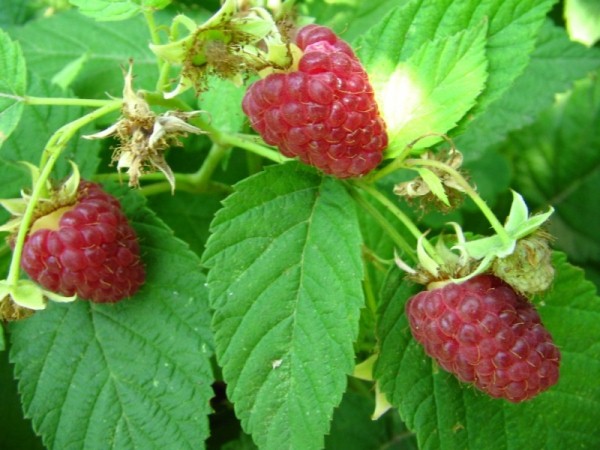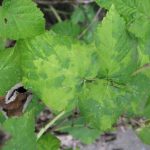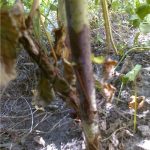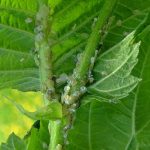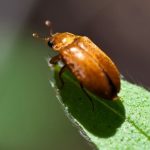Raspberry has a wonderful taste and many useful properties, known since ancient times. For example she perfectly relieves fever and malaise. Therefore, the majority of summer residents are involved in growing this crop. Below you can find a description and description of the raspberry Indian summer variety.
Table of contents
Description of the variety
It is the first remontant raspberry variety produced by the Russian scientist, who was I.V. Cossacks.It turned out “Indian Summer” from the crossing of “Kostinbrodskaya” and “News of Kuzmina”.
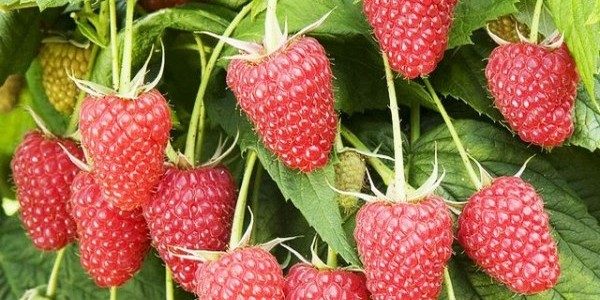
Best suited for cultivation in the North-West, Central and North Caucasus regions. This variety does not tolerate drought and excessively high temperatures., which makes it impossible to grow in the southern regions. Also excluded a territory with a cold climate.
If the gardener receives two crops at once, then annual and biennial shoots are used. In this case, the first wave of berries will appear in the first days of summerThe fruiting period lasts until mid-July. Then, in early September, the ripening of berries continues, and lasts until mid-October.
If you use only annual shoots, then you can harvest in August, and in this case it will be much more than when using the first method. Average, from one bush can be collected from 1 to 3 kilograms of berries.
Raspberry bush is characterized by the presence of medium sized shoots with stiff and thin spines. Also they have a light wax coating. The color of the shoots is pinkish.
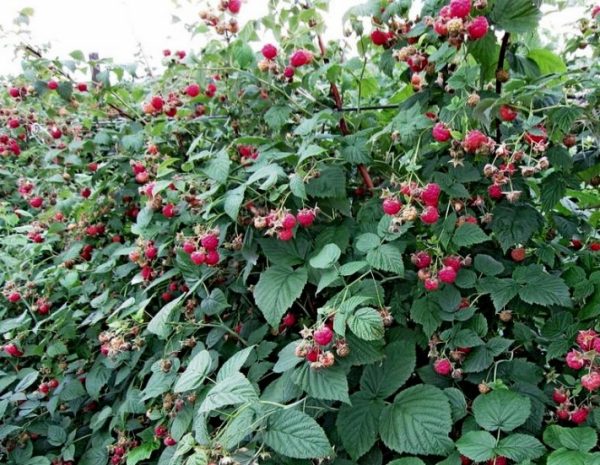
This variety is frost resistantbecause it is experiencing cold to -30 degrees.The main condition is the presence of shelter, in the role of which snow cover or a structure constructed by man can play.
The advantages and disadvantages of the variety
Advantages:
- The main advantage -repairability, the harvest can be obtained from annual and from two-year shoots.
- If desired you can pick berries in the cold, autumn period.
- They do not lose their taste and do not turn sour during heavy rainfall.
- Has immunity in relation to diseases such as curl or gray mold.
- With enough snow cover tolerates temperatures up to -30 degrees.
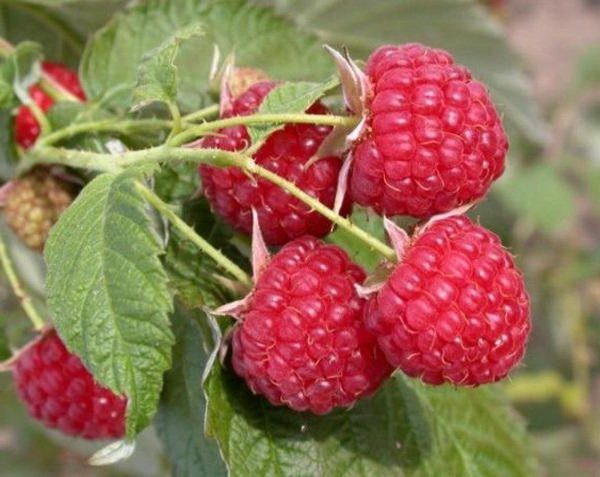
Disadvantages:
- Low yield varieties.
- Poorly transportedtherefore it is more suitable for fresh consumption or early processing.
- Has a tendency to powdery mildew or purple spot.
- Education new shoots going on long enough.
Appearance of bushes and berries of raspberry Indian summer
The raspberry bush is distinguished by a relatively small growth, approximately 1-1.5 meters, and it also cannot boast of a strong spreading and density. Growth is poorly formed, only 10-15 pieces per m2. Themselves shoots or buds strongly branched. The leaves are dark green in color, small in size, with small wrinkles and a smooth surface.
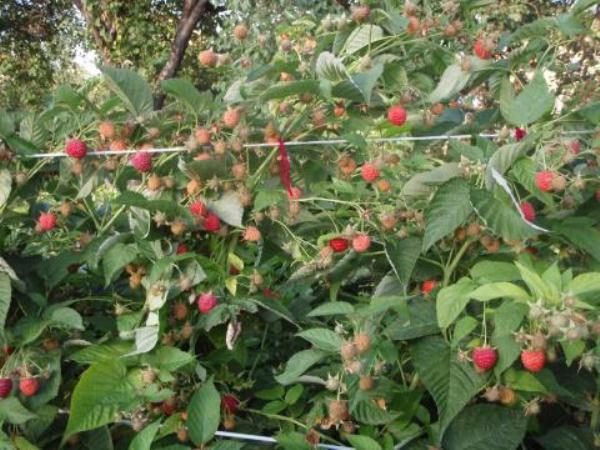
The color of the berries is bright red, the shape of a truncated cone. Size may vary from 2.5 to 3.5 grams. To taste, they are juicy, sweet-sour, practically have no flavor.
Planting and trimming rules
In order for the raspberry to bring a good harvest and not die before the deadline you need to choose the right place for landing.
- It is betteruse the southern part of the plotbut.
- Also welcome shelter from drafts and strong winds (maybe a wall of a house or another building).
- Ground water level must not exceed 1.5 meters from the ground.
- You can not plant raspberry bushes constantly in the same place, because the root system of this plant releases specific substances into the soil. Because of this, the full growth of new bushes is possible only in 5-7 years.
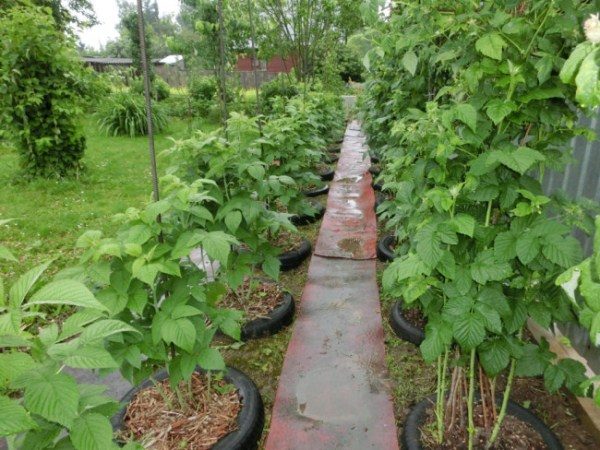
You can plant raspberries at any time of the year, but the best period is considered the end of September - the beginning of OctoberI. What would the plant got accustomed as quickly as possiblefollow the rules:
- The best thing prepare a trench with a depth and width of half a meter.
- To make the soil more nutritious, humus is placed on the bottom, top peat and compost. 2-3 buckets of such a mixture are used per square meter. Also added one cup of mineral fertilizers.
- What would be better to secure their roots sprinkled with fertile soil and carefully tamped.
- To complete the procedure each bush is watered with 6 liters of water and mulch with mowed grass or other organic matter.
There are several options for the location of raspberry bushes:
- Spacing between rowsequal to 2 meters, and between the saplings 1 meter.
- Can choose square-shaped plot with sides of 1-1.5 meters, and place the bushes in each of the corners.
Pruning
- If a use raspberries for two seasonsthen at the end of the fruiting period the shoots must be simply bent down to the ground.
- In that case, when bush used as an annual plante, shoots pruned at the root.
Care and reproduction
The repair raspberry loves moisture, and can suffer greatly from its absence. Do not let the root system dry out, because in this case the complete destruction of the plant is possible. It is best to produce watering daily. Currently, there are many technical means for the implementation of this procedure, such as a drip system.
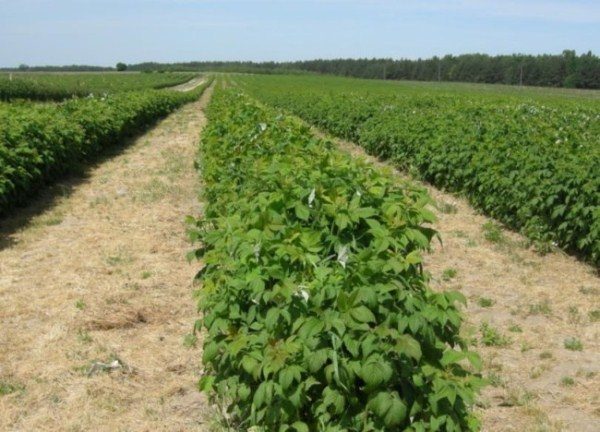
Be sure to loosen the ground. But don't forget that raspberries have a very fragile root systemwhich cannot be damaged, therefore even at a distance of one meter from a bush it is impossible to dig up the soil for more than 4-6 centimeters.
Top dressing
April, May and June are considered the best months for fertilizers such as chicken litter solution (1:20) or slurry (1:10).
In the same period, mineral fertilizers are added, which can be prepared independently, using the following components:
- Saltpeter - 15 grams;
- Superphosphate - 40 grams;
- Potassium sulphate - 20 grams.
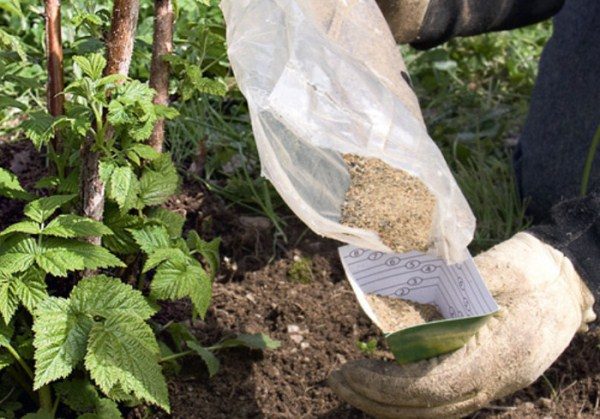
Autumn is the period for contributing potassium sulphideIt is important not to overdo it; a maximum of 30 grams of fertilizer is used per square meter of soil.
Breeding
Raspberries are propagated by root suckers. To start, a young shoot is separated, no more than 20 centimeters high, the color of the roots must be white. This indicator indicates the health of the selected escape. After it is placed in the ground, as during the initial landing. It is best to perform such actions in late May - early June. If the root system is not damaged, the harvest will be available already for the next season.
Preparing for the winter
- If growing raspberries as an annual crop, before the onset of frost it is necessary to cut off all the shoots and carefully mulch the soil.
- If you leave the shoots, then among them you need to choose the strongest, the rest are removed. Before the cold, they need to bend down to the ground and fix in this position with the help of pegs.
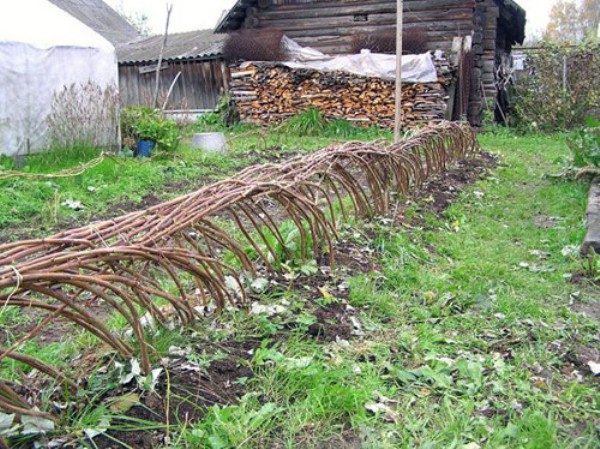
- In order for the roots to survive the frost better, you need to thoroughly moisten them, heavily watering bushes by the end of the season.
- If the winter is not snowy raspberries need extra cover.
- In order to save the snow cover fences are installedthat will protect it from windblowing.
Peculiarities of this raspberry variety
The main feature will be repairable, that is, the ability to grow berries, both on annual and biennial shoots.Indian summer variety can be harvested twice a year.in summer and autumn. It is also possible to grow raspberries only for autumnal fruiting, in which case it will be more abundant than with double harvesting.
If you use the autumn planting, then in no case can not be cut off the upper part of the shoot, as in the spring planting. Because the part to be removed contains important substances for the formation of new buds and inflorescences. Or, the plant may begin to sharply grow the lost element, and simply die at the time of frost.
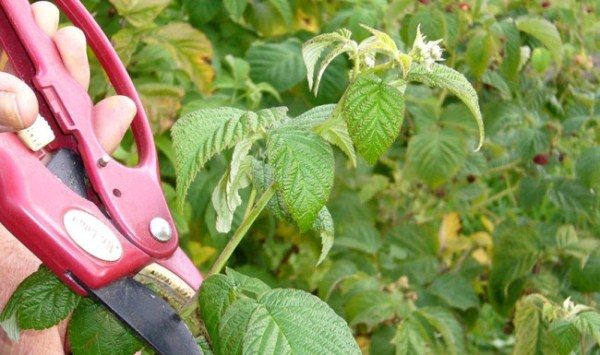
As you know, raspberry Indian summer loves moisture. AND If you can not constantly water the plant, you can do the following: produce watering, the volume of three times the normal portion, after which the ground around the roots must be carefully mulched to keep as much moisture as possible.
To increase the yield, you need time to cut the raspberry bushes. To the old branches do not interfere with the young. Also, do not forget about timely watering and regular feeding.
Diseases and pests
Indian summer often exposed to disease, here are some of them:
- Purple spot - on young shoots appear brown spots that grow and lead to the complete withering of the affected area. It must be removed so as not to infect healthy branches. For prevention, in the springtime, the bushes are sprayed with 1% Brodsky liquid and Hom.
- Mealy dew - in warm and humid weather, white bloom appears on the leaves and berries.Spraying with Topaz or Fundazole will help get rid of it.
- Leaf mosaic - White and dark spots appear that are arranged in a mosaic shape. To cure this disease is impossible, so you have to remove the affected areas.
- Raspberry aphid - likes to settle on young shoots, leaves curl and fade quickly. To get rid of aphids need to cut the populated place and burn. Spring prevention will be a solution of malathion.
- Spider mite - it feeds on sap from the leaves of a plant; a tick can be recognized by a thin web on a bush and light, eroded spots. In the fight against it can help Fitoverm or Vermitek.
- Raspberry beetle - the larvae of this beetle feed on berries, which significantly reduces yield. In this case, apply a solution of potassium permanganate or the drug Spark.
- Spider mite
- Leaf mosaic
- Purple spot
- Raspberry aphid
- Raspberry beetle
Reviews
I really like Indian summer for the sweetness and unobtrusive aroma, but it requires a lot of attention. In addition, the berries are very small and with a double harvest do not have time to ripen on the annual shoots. - Svetulya
There are varieties much better than Indian summer, but I like this raspberry with my taste. The berries, though small, are many. Of the minuses, you can still say about the strong height of the bush, above all, it requires a garter. - Helena
This variety has a creeping root system, so it is best to insulate the roots underground. I love “Indian Summer” for the opportunity to pamper yourself with fresh berries, even in the late fall. I also want to say that they are difficult to transport, they quickly crumple and lose their shape. - Olesya
Although Indian summer variety is distinguished by a large number of drawbacks, all of them are ruined by the opportunity to feast on raspberries in the fall. Besides, berries are very tasty and beautiful. The main problem is the need for constant care and attention.
